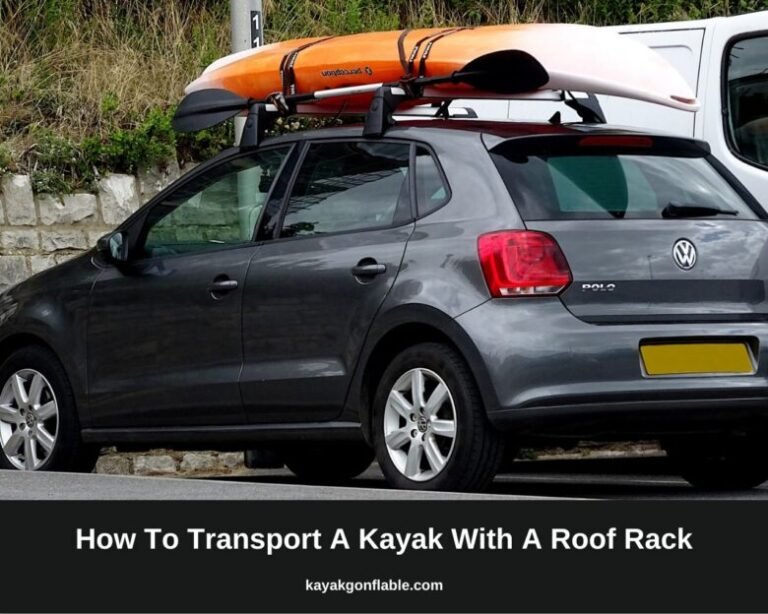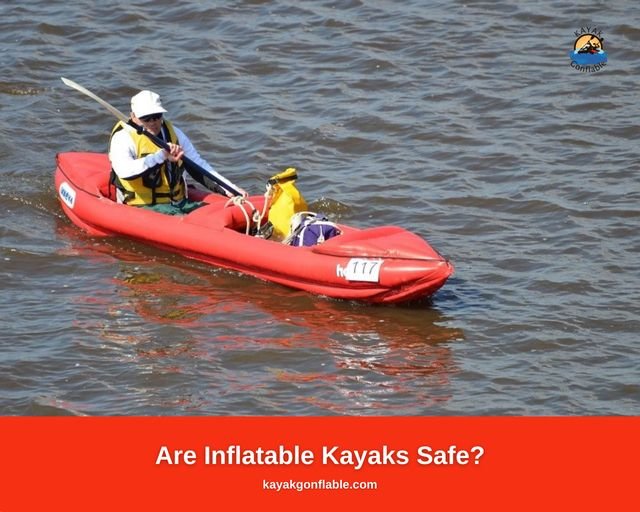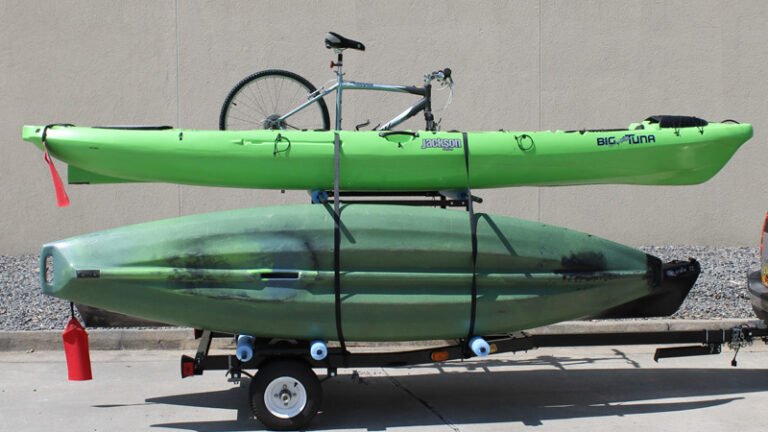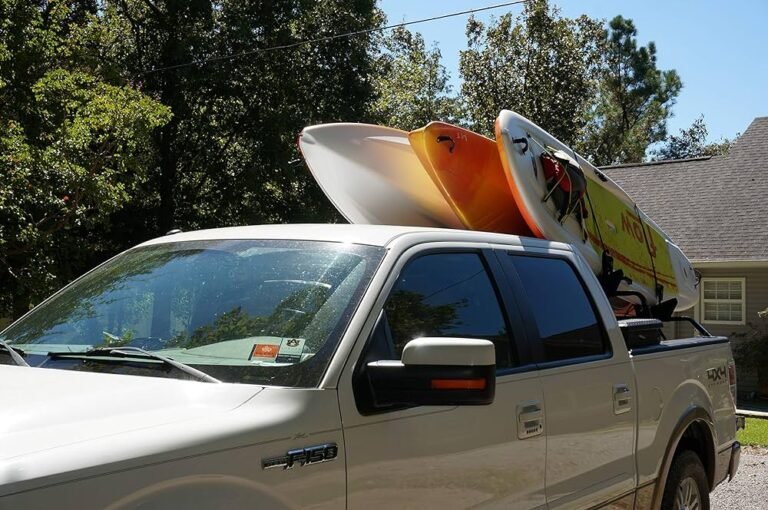How To Strap A Kayak To A Roof Rack
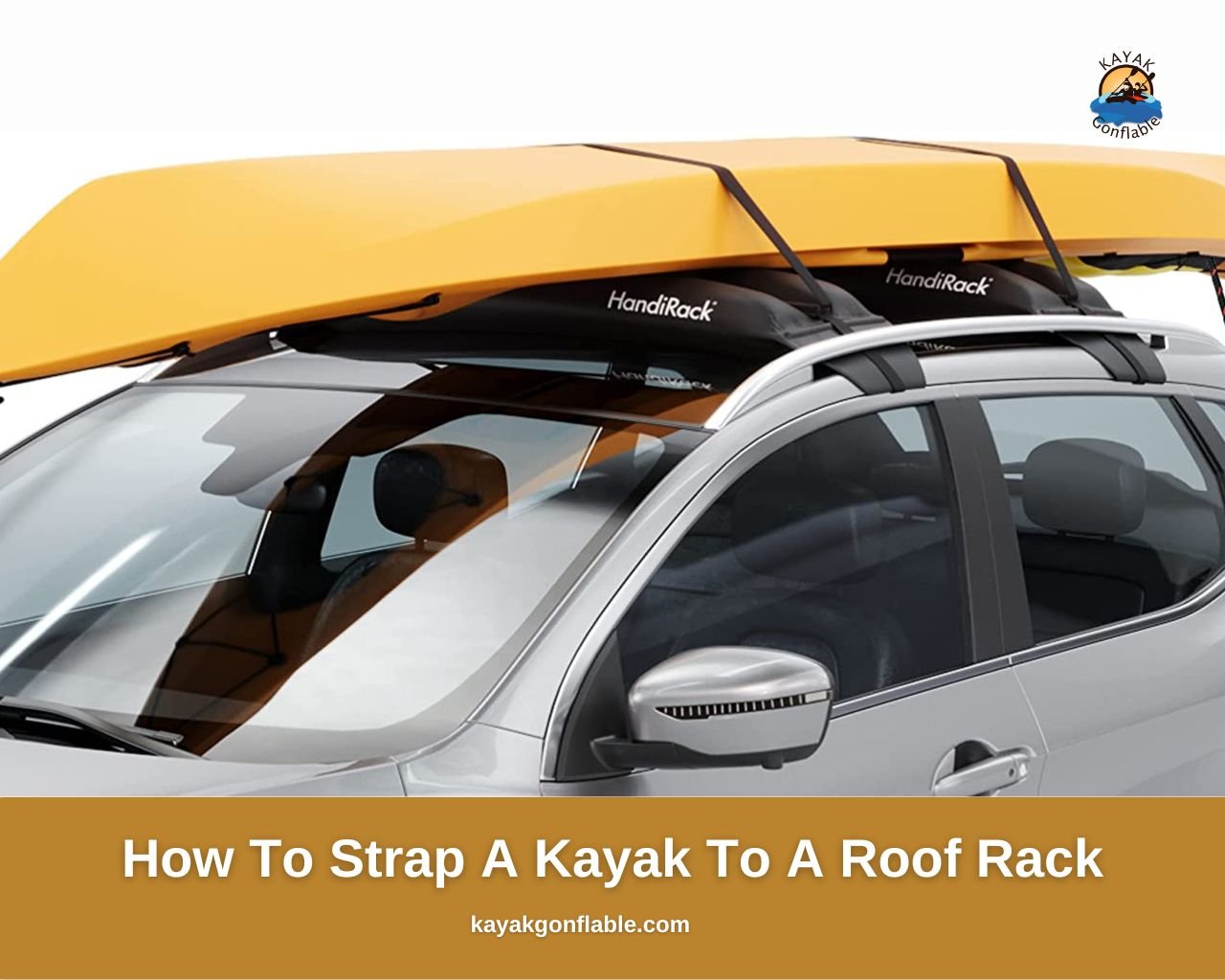
Kayaking is a popular watersport that involves navigating a narrow, lightweight watercraft called a kayak with the use of a double-bladed paddle. As the sport gains popularity, more and more people own their own kayaks.
This naturally leads to the question of how to transport the watercraft. Inflatable kayaks are easy to move from one place to another; you simply deflate and pack them and you are good to go.
Other kayaks, however, require more skill for safe transport. Again, the issue of storing kayaks comes to mind, as these watercraft should be kept shielded from the elements, moisture, dirt, and animals.
Though several solutions exist to the aforementioned problems, the use of kayak racks is very efficient both for transportation and storage. Kayak roof racks are famously fitted to the roof of your vehicle, then your kayak is strapped to them for transport.
Kayak racks are also useful in both indoor and outdoor kayak storage as they provide an elevated position from the ground for storing kayaks.
It goes without saying, then, that kayak owners have to familiarize themselves with how to securely attach a kayak to a roof rack safely.
This knowledge is important because securely strapping the kayak to the roof rack will keep your mind at ease that no accidents will occur while in transit.
It also assures you that no damage will be done to either your vehicle or the kayak for as long as the watercraft is on the roof rack. We explore how to securely strap a kayak to a kayak rack in this article.
What Is A Kayak Rack?
A kayak rack is a convenient way to transport your kayaks without having to carry them. A kayak rack is a mounting system or device that consists of a series of metal or plastic bars that are mounted on the roof of a vehicle or a wall.
The bars hold the kayaks in place and allow them to be easily transported or stored. There are several types of kayak racks, but we focus on roof racks in this article.
Kayak roof racks are for easy transportation of kayaks and are fitted to the roof of the vehicle. They may be made to carry one or multiple kayaks.
Why Use A Kayak Rack?
Kayak racks are a convenient way to transport and store your kayak but they are not the only way. Some reasons why kayak racks are preferred by many are given below.
- Kayak racks make it easy to transport your kayaks from one location to another.
- Kayak racks can also help keep your kayaks safe when not in use, as they can be stored out of the way on the rack.
- Racks help save space in your garage (during storage) or trunk (during transport) by providing a secure and fixed place for the kayak, ensuring orderliness and easy retrieval.
- Kayak racks are designed to mitigate damage to your kayak or vehicle during transport.
- Racks are also easy to install, so you can install them yourself with no need for aid.
- Kayak roof racks are also very affordable, and they come with a variety of features for easy use.
- Roof racks are typically made from aluminum or steel, so they can be used to transport kayaks without fear of damage.
Which Kind Of Roof Racks Should You Get?
Kayaking is a great way to get some exercise and see some amazing views. However, if you’re not careful with your belongings, your kayak can quickly become damaged, especially during transport.
If you own a kayak, it’s important to consider owning a roof rack to help you with moving your kayak from place to place There are a variety of roof racks that can be used with a kayak, from simple crossbars to more elaborate systems.
To help with choosing a roof rack if you don’t own one already, we will briefly discuss some popular roof rack types.
J-Style Roof Rack
There are several different racks available, each with its own set of advantages and disadvantages, but a popular option is the J-style kayak roof rack. This rack is simple to use and can be fitted to most vehicles.
It is also versatile, adjustable, and capable of carrying a wide range of kayaks. J-style racks are made from heavy-gauge steel and are designed to support large kayaks. They also come with built-in cable locks to keep your kayak secured.
Crossbars
Crossbars are found on many vehicles and provide a convenient place or frame to attach your kayak rack to your vehicle.
The beauty of crossbars is that you can load a kayak directly onto them and transport it safely, so mounting a kayak rack on your crossbars is just for additional safety. Crossbars are the trailblazers of many types of roof racks found today.
Saddles
If you’re looking for an easy and secure way to transport your kayak, a saddle kayak roof rack is an excellent option. These racks attach to the roof of your car and can hold up to three kayaks.
They’re also relatively easy to install, making them a great choice if you have limited mobility or storage space. Saddle roof racks are horizontal racks that provide a place for your kayak to sit during transit.
Saddle racks boast the largest surface area for your kayak to sit on, so they are suitable for large kayaks. You can easily load your kayak onto this rack from the rear of your vehicle. Saddle rack systems are often custom-fitted for each vehicle.
Pads
These racks are either foam or inflatable. Inflatable kayak roof racks are perfect for transporting your kayak without any hassle. The roof rack is made out of a durable, waterproof material that can hold up to 100 pounds.
It also includes straps to secure the kayak in place and a built-in pump to inflate the rack in just a few minutes. Inflatable kayak roof racks are easy to install and fit most vehicles.
Foam kayak roof racks are a great way to transport your kayak as they are lightweight and don’t add much weight to your vehicle while providing a safe way to transport your kayak.
The best foam kayak roof racks are adjustable, providing a custom fit for each vehicle. They’re also easy to install and remove, making them perfect for car camping or day trips.
Rollers
Kayaking can be very enjoyable, and one of the best ways to enjoy it is by using a kayak roof rack to eliminate stress when transporting your watercraft.
Kayak roof racks come in a variety of shapes and sizes, but one of the most popular types is the roller kayak roof rack.
Roller kayak roof racks are famous for making it particularly easy to load your kayak onto your vehicle. They are also very versatile, as they can be used with most types of vehicles.
Roller roof racks are also easy to remove from the vehicle, so you can bring them out when you are ready for a trip and store them the rest of the time if you so desire.
What You’ll Need
Once you’ve decided to transport your kayak with a roof rack fitted to your vehicle, you have to know what equipment you’ll need to successfully strap the kayak to the rack and then transport it. The equipment you’ll need is given below.
- A Kayak: To strap a kayak to a roof rack, you first have to have a kayak at hand. The kayak could be yours, a friend’s, or even one you rented. Once you have the kayak you intend to transport, you can get the other necessary accessories.
- A Vehicle: The next thing you will need is a vehicle (usually a car or truck) to attach the roof rack to. This equipment is very crucial as the vehicle is what will move your kayak from where you are to your intended destination once you strap your watercraft to the roof rack. Again, you can use your vehicle or rent one.
- A Roof Rack: Once you have your kayak and vehicle, you then need a roof rack if you indeed intend to transport the kayak with a roof rack. Several brands exist, and some rack types were briefly discussed to help you make your choice. After careful research, you should pick a roof rack that suits your vehicle’s roof, your kayak, and your personal preference.
- Padding: You need padding when strapping your kayak to a roof rack to mitigate damage to your kayak and vehicle. Inflatable roof racks do not typically require padding as they inherently perform the function of padding.
- Tie-Down Straps: Tie-down straps are often an accessory needed when strapping a kayak to a roof rack, as they can help keep the kayak in place and prevent it from shifting while in transit. They are thus a great way to keep your kayak secure while transporting it on your car or truck. Tie-down straps also make it easier to remove the kayak from the rack if necessary. When selecting the right tie-down straps, make sure that they are strong enough to support your kayak’s weight and also fit properly on your vehicle. You are typically expected to have straps for each crossbar, but it doesn’t hurt to have extra straps just in case that is not enough. When getting straps for securing your kayak, it is advisable to go for straps with cam buckles as they help you easily secure your kayak without tying knots.
- Bungee Cords: An alternative to straps is bungee cords. Bungee cords are an essential accessory for anyone who wants to strap a kayak to a roof rack. They provide a quick and easy way to secure the kayak, making it easy to transport wherever you go. Bungee cords are also a great way to keep your kayak secure while you’re driving. Bungee cords come in different sizes and strengths, so they can handle most kayaks. Some people prefer to use bungee cords because they are lightweight and easy to carry. Others find that they hold the kayak more securely than straps.
- Bow Tie-Down Straps: These are straps you need specifically for securing the front and the back or the bow and the stern of your kayak. You can also make use of bungee cords or other strong ropes if you so prefer to securely tie down the bow and stern of your kayak and prevent the vessel from moving to and fro while in transit.
- Tarpaulin: Tarpaulin, sometimes referred to as a tarp, is a fabric made from strong cotton or synthetic fabric with a water-repellent finish. Tarpaulins are often used as roofing materials, coverings for tools and vehicles, and ground coverings. The term “tarpaulin” may also refer to the type of equipment used to make the fabric. You need a tarpaulin not to strap your kayak to the roof rack but to protect it from the elements while on your trip. It is common knowledge that moisture, the sun’s ultraviolet rays, and other elements deteriorate kayaks, so you need tarps to defend against them.
How To Strap A Kayak To A Roof Rack
Once you have all the necessary accessories, you are ready to strap your kayak to the roof rack. The procedure to safely and securely strap your kayak to a roof rack is given below.
Step 1: Install The Kayak Roof Rack
The first step in this journey, once you’ve got all the required equipment, is to install the roof rack on the roof of your vehicle. You can do this yourself or get someone to do it for you.
You should, however, make sure the roof rack is well fitted to the vehicle’s roof and in no danger of coming off as should that happen, your kayak could fall off the vehicle and get damaged or worse, cause an accident on the road.
How To Install A Kayak Rack?
Kayaking can be a great way to get some aerobic exercise and see some beautiful scenery. However, if you’re not using a kayak rack, getting your kayak from one place to another can be a hassle. Here are seven easy tips for installing a kayak rack:
- Measure the space where you plan to install your rack. Make sure the dimensions of the rack you purchase fit within the space you’ve designated.
- Purchase an adjustable or universal kayak rack. These racks are very popular because they can fit almost any type of kayak. You can purchase a specific rack if it fits your kayak, vehicle, and preferences.
- Make sure you have all the necessary hardware before installing a kayak rack. You will need hinges, bolts, and nuts to attach the rack to the vehicle. Most racks require an Allen wrench, so you might need that too. You can either purchase the required tools or borrow them.
- Make sure the rack and hardware are corrosion-free and heavy-duty. They should also be resistant to the elements for the rack to stand the test of time.
- Read the manufacturer’s instructions carefully before starting your installation. It is crucial you adhere to all instructions to avoid complications.
- Take your time when installing a kayak rack. Taking your time ensures you do a clean job with no mistakes.
- Double-check your work. This is to make sure any error committed is quickly spotted and rectified to prevent accidents.
Step 2: Spread The Straps Over The Roof Rack
If you are making use of straps, you are required to spread them over each bar of the rack. You place the straps this way so it will be easy to secure the kayak to the rack when the time comes. You can do something similar if you decide to work with bungee cords or other strong ropes.
You should be careful, however, if you are using straps, so the buckles do not scratch against your vehicle’s roof and disfigure it, especially if you are concerned about the aesthetic state of your vehicle.
The straps mustn’t be loose if they are going to keep the kayak in place, so you should tighten them if they are loose.
Another thing to keep in mind is that the heavier and longer the kayak you want to strap down, the more straps will be needed to secure it.
Similarly, the more kayaks you are strapping to the roof rack, the more straps or cords (if you are using them) will be required to securely strap the kayaks down.
Step 3: Position The Kayak On The Roof Rack
Once your straps are ready, you are to load the kayak onto the roof rack. Positioning the kayak in the right spot for strapping is crucial as it plays a vital role in how safe and secure the kayak will be once the ordeal is done.
If you are up to the task, you can lift the kayak to your vehicle’s roof on your own. If you are not confident you can safely lift the kayak, however, it is best to get help from a friend, neighbor, or other individual to assist you with lifting the kayak to the roof rack.
Depending on your kayak and the roof rack you are using, you may have to load the kayak in a particular way.
For instance, it is usually best to position the kayak upside down if you are placing it directly on the crossbars, while when using pads or rollers, the kayak is best loaded right side up.
Another thing to take note of is where the kayak would face, and this depends on the type of kayak. With most kayaks, the front of the kayak should face forward, but you should still consult with your kayak manufacturer to be sure.
The kayak should also be placed at the center of the roof rack for added security unless you are strapping down more than one kayak for transport.
If you are transporting more than one kayak, you should load them all onto the rack or load them as recommended before proceeding to the next step.
Step 4: Secure The Kayak To The Roof Rack
After correctly positioning your kayak, you proceed to secure it so it can’t move, thus ensuring its safety for as long as it is strapped down to the roof rack. To accomplish this task, you can make use of the tie-down straps or bungee cords that you laid on the rack earlier.
Remember that cam straps are the most advisable to use for this stage, as not only do they not require knots when securing the kayak, but they are also easy to adjust when tightening.
If you choose to use bungee cords or other strong cords, make sure the knots are well-made and will not come undone. You can invest in learning how to tie proper knots before this moment to help with that and ensure you securely attach your kayak to the roof rack.
The type of roof rack you use will also play a role in how you strap down your vessel to the roof rack. The ratio is typically one strap per crossbar, but it may change depending on the type of roof rack you are using and how many kayaks you are strapping down.
You should make sure the straps or cords are not twisted and are tightened properly to secure your kayak to the roof rack.
Step 5: Secure The Kayak’s Bow And Stern
For the kayak to be completely attached to your vehicle, it is crucial to tie down its bow and stern. This could be done with the bow tie-down straps, bungee cords, or other strong ropes in your possession.
The handles on the bow and stern of the kayak are useful at this stage if your kayak has them. Tie a strap or cord to a suitable handle on the bow, then tie the other end of the strap or cord to the tow hook of your vehicle with moderate tension.
Moderate tension is required as if you secure the kayak too tightly, you could deform it, which would be counterproductive. You should repeat this procedure with the stern of the kayak to ensure the kayak is properly secured.
Step 6: Doublecheck Your Work
Once you’ve gone through the aforementioned steps, your kayak should be well-strapped down to the roof rack with no chance of falling off but you can never be too careful.
Patiently inspect your work checking the straps or cords one after the other to make sure they are well fastened with moderate tension and the kayak has no chance of moving.
You should always check that the kayak is secured before embarking on your journey, especially if the kayak has been strapped to the vehicle’s roof for some time without supervision.
That way, you can be sure of your watercraft’s safety during the trip. Once that is done, you can use the tarpaulin to cover your kayak and protect it from the elements.
Remember that maintenance is crucial if you want something to last and be in good condition, so always ensure your kayak is well-treated and protected from the wrath of the elements and other things that would damage it as time goes by.
Transporting Your Kayak
Once the kayak is secured and your gear is in order, you are ready to hit the road. Ensure you abide by all kayak transportation rules in your state, along your travel route, and at your destination to avoid getting into legal trouble and having your trip cut short.
Also, drive safely at a reasonable speed and perform periodic checks to ensure the kayak is still secured. Once at your destination, unload your gear and start your adventure. Have fun!
Kayaking is a popular sport known for providing a way to enjoy the outdoors, see beautiful scenery, work out, and relax.
However, kayaks, the main equipment of the sport, tend to be challenging to move from one place to another by those who would enjoy the joys of kayaking.
One way to facilitate transport is to strap your kayak to a roof rack fitted to your vehicle, so learning how to safely strap a kayak to a roof rack is crucial knowledge all kayakers should possess.
After obtaining all the necessary equipment, the kayaker is to install the rack on the roof of his vehicle, lay some straps or cords down on the rack, and then proceed to correctly load the kayak onto the roof rack.
Correctly positioning the kayak is key to securing it, and the way and position in which the kayak should be loaded onto the vehicle depend on the kayak and rack type.
The kayaker should then secure the kayak with the straps and take the time to tie down the bow and stern of the kayak to the vessel for reinforcement.
Also, ensure you use padding to protect your kayak and vehicle. After protecting the watercraft with a tarpaulin, you can drive to your destination while obeying all the necessary rules.
Applying these principles helps you safely transport your kayak from place to place, and you can be kayaking in no time. Remember to always wear a life jacket and employ safe kayaking practices. Have fun on the water, and thank you for reading!


